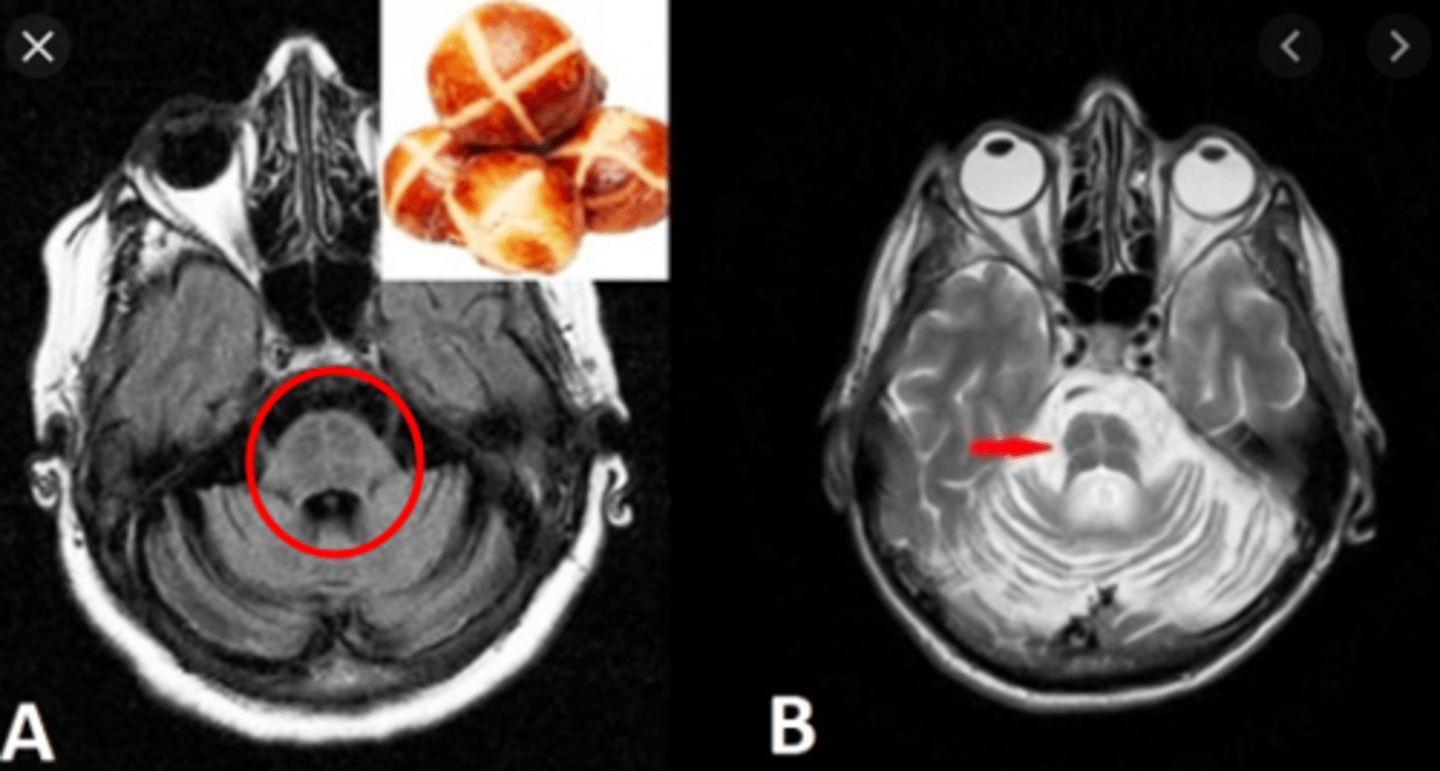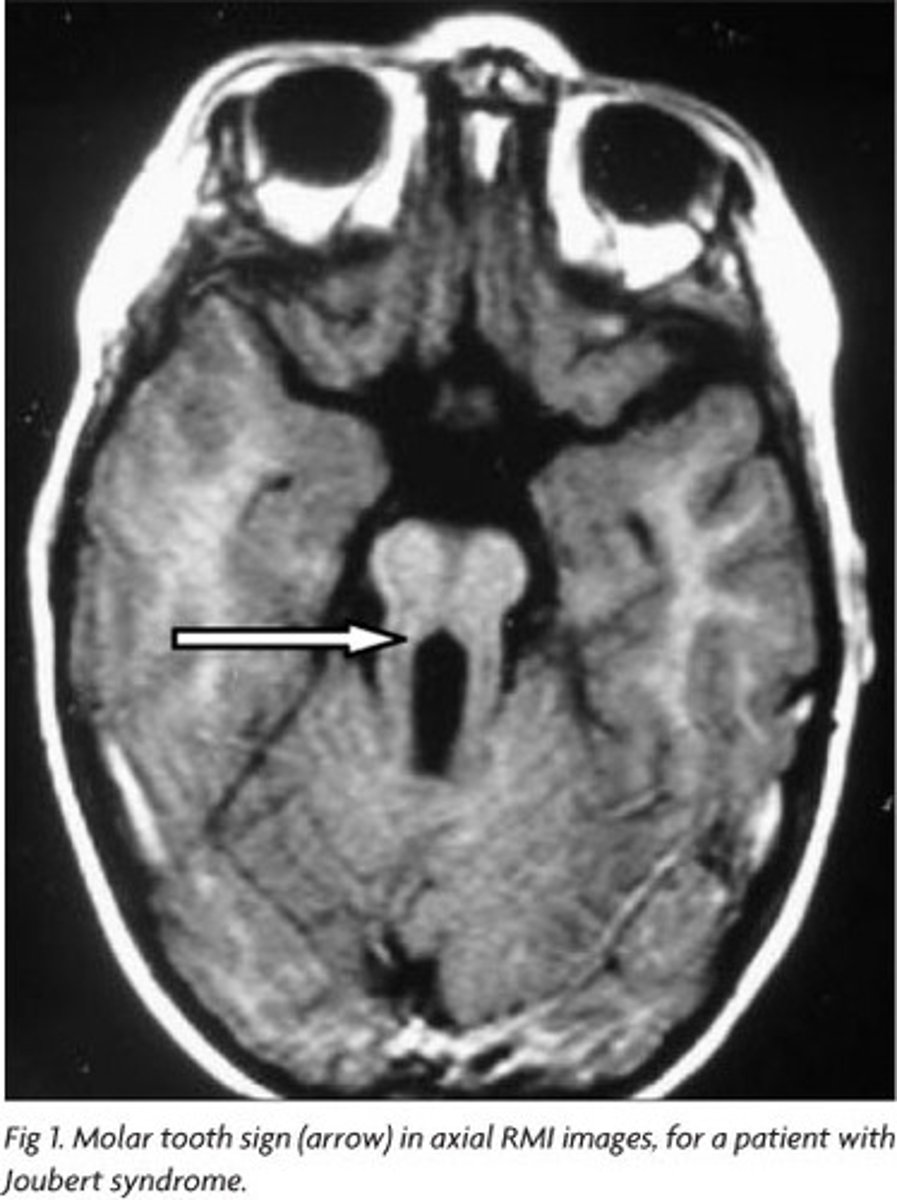Ocular Motility #14: Ataxia and Apraxia
1/76
There's no tags or description
Looks like no tags are added yet.
Name | Mastery | Learn | Test | Matching | Spaced |
|---|
No study sessions yet.
77 Terms
What is the difference between oculomotor ataxia and apraxia?
Ataxia = clumsiness
Apraxia = long latency
Which of the AD types of SCA causes pigmentary retinopathy?
SCA 7
What are the 7 autosomal dominant types of SCA?
SCA 1, 2, 3, 6, 7, 8, 20
What are the 3 recessive types of SCA?
1) Friedreich Ataxia
2) SCA with Saccadic Intrusions
Name the 3 stress-induced ataxias and how to treat them?
1) Episodic Ataxia Type I
-Diamox
2) Episodic Ataxia Type II
3) Benign Recurrent Vertigo
Episodic Ataxia Type 1
Typically in 2-20 year olds with AD inheritance
-short episodes (sec to min)
-eyelid myokymia of the levator or orbicularis
What can trigger a Type 1 Episodic Ataxia?
exercise or the startle reflex
****Treatment of choice for Type 1 Episodic Ataxia
Diamox
Second choice medication for Type 1 Episodic Ataxia
Ampyra
Type 2 Episodic Ataxia
Also AD inheritance, but happens in adults up to 30 yo at the time of diagnosis (instead of 2-20 for Type 1)
-episodes last HOURS instead of sec/min
Type 1 vs. Type 2 Episodic Ataxia: inheritance
Both AD
Type 1 vs. Type 2 Episodic Ataxia: duration of episodes
Type 1: seconds to minutes
Type 2: hours
Type 1 vs. Type 2 Episodic Ataxia: age of diagnosis
Type 1: 2-20
Type 2: adulthood through 30's
Type 1 vs. Type 2 Episodic Ataxia: triggers
Type 1: exercise or startle reflex
Type 2: 50% migraines! The rest is from exercise, caffeine, fight or flight stress
Type 1 vs. Type 2 Episodic Ataxia: ocular signs
Type 1: myokymia of the levator or orbicularis
Type 2: nystagmus, irregular VOR, irregular OKN, irregular pursuits / saccades, migraine pain
Type 1 vs. Type 2 Episodic Ataxia: treatment
Type 1: Diamox (ampyra is a second best option too)
Type 2: Diamox (90% success)
Benign Recurrent Vertigo
dizziness episodes that are often associated with trigeminal neuralgia
Benign Recurrent Vertigo: demographic
up to 50 year olds, x2 females > males
Benign Recurrent Vertigo: duration
minutes to hours
Benign Recurrent Vertigo: triggers
Headaches (75%)
Also sleep deprivation, hormonal changes, stress
Benign Recurrent Vertigo: treatment
Diamox (70% success)
What foods are possible triggers for pain when someone with Benign Recurrent Vertigo is experiencing hyperactive trigeminal neuralgia?
Spicy foods like salsa, chili, hot sauce OR foods that are very cold like ice cream
***Review the colorful figure 10-12 in Wong on page 173, it's super organized for comparing the 3 stress induced ataxias
Spinocerebellar Ataxia / atrophy (SCA)
a category genetic diseases that result in slow loss of coordination of all muscle movements, including gait and eye movements
Spinocerebellar Ataxia / atrophy (SCA): treatment
No known cure :(
SCA 1 has the greatest number of cases in what 2 countries?
Italy and South Africa
SCA 1 was the first discovered SCA, usually having onset around age _____, but can start as early as ___
40,10
Describe SCA 1 saccades and nystagmus
hypermetric and slow saccades
gaze evoked and rebound nystagmus
SCA 1 progresses for _____ years before causing death :(
15 years
*****SCA 1 causes what unique pupil finding?
SCA 1 causes near-light dissociation due to optic nerve pallor!!!!!!
SCA 2 is also known as
olivopontocerebellar atrophy
SCA 2 has highest rates in what countries?
Cuba is the most prevalent
Also: Italy, India, Singapore, USA
SCA 2 demographics
usually starts in 30's-40's
SCA 2 progresses for _____ years before causing death :(
10
Describe SCA 2 saccades
slow but accurate saccades
Other signs of SCA 2
areflexia (loss of reflexes) and dysarthria (trouble talking)
SCA 3 is also called
Machado-Joseph Disease
SCA 3 has the same avg age of onset and lifespan as the previous two, but SCA 3 can occur as late as age ____
70
SCA 3 saccades and nystagmus
hypometric VOR, gaze evoked nystagmus, slow saccades
What part of the world is SCA 3 most prevalent?
#1 Portugal
also Brazil, China, and USA
****What unique ocular finding is associated with SCA 3 Machado Joseph disease?
Chorioretinal atrophy
SCA 6 is also called
Holmes Type
SCA 6 onset and lifespan
as late as 60's, but lifespan is 25 years!
SCA 6: demographic
Most common in Germany and Japan
-also seen in USA
SCA 6 nystagmus and vertigo
positional vertigo with downbeat nystagmus
****Unique finding for SCA 6 on MRI?
Cross sign on the pons, and cerebellum has atrophy

********WHICH SCA HAS THE CROSS SIGN
6

SCA 7 is also called
ADCA2 of Harding
SCA 7 can be seen as early as age _____ and can last up to ______ years, but an earlier onset correlates with a shorter lifespan
1, 45
****Unique ocular characteristic of SCA 7
Pigmentary Maculopathy
SCA 7 demographics
Most common in South America, Netherlands, and USA, also China
Ocular appearance of SCA 7
bilateral oculomotor III palsy with pigmentary maculopathy
SCA 8 is also called
Saccadic dysmetria
SCA 8 demographics
avg age is 40, but these patients have normal lifespans!!!!!!!!
Main ocular symptom of SCA 8
horizontal nystagmus
****SCA 8 saccades
very Hypermetric overshooting
Haw River Syndrome
ataxia and dementia are universal, children will have myoclonus epilepsy and intellectual disabilities, while adults will have choreoathetosis and dementia
The most common of the recessive ataxias
Friedreich Ataxia
Friedreich Ataxia
poor fixations, saccadic dysmetria, ocular flutter, and square wave jerks
***What conditions are correlated with having Friedreich Ataxia
Gluten sensitivity
Diabetes
Scoliosis
SCA with Saccadic Intrusions (SCASI)
poor fixations due to MACROsaccadic oscillations that cause decreased foveation time
-major jiggling of the eyes when doing saccades
Define apraxia
inability to initiate otherwise voluntary skeletal muscle movements, like saccades, in a timely manner. Unlike ataxia, eye movements ARE ACCURATE once they initiate, it just takes a long time to do them
True or false: Reflexive eye movements are NOT affected by apraxia
True, because they are not voluntary! ie reflexive saccades are initiated by superior colliculus
****Apraxia can be compared to what condition, and what drug can be used for both?
Parkinson Disease
L-Dopa or Levodopa!!! it can help ocular motor apraxia too!!!
What are the 3 forms of congenital oculomotor apraxia?
1) Cogan OM Apraxia
2) Ataxia Telangiectasia
3) Joubert Syndrome
How do babies with apraxia react to compensate?
They do huge head thrusts to shove their eyes involuntarily in the opposite direction using VOR to look around
****What are the neurological causes of cogan oculomotor apraxia?
1) agenesis of corpus callosum (it never formed)
2) aqueductal stenosis of the 4th ventricle and multiple arachnoid cysts causing hydrocephalus
3) cerebellar atrophy esp. vermis
True or false: head-eye coordination is often normal for kids with congenital oculomotor apraxia of Cogan
True
Cogan OM apraxia: saccadic amplitude and latency
hypometric small amplitude, longer latency "intermittent saccadic initiation failure"
***True or false: Cogan apraxia is not progressive and does not affect lifespan
True
Ataxia Telangiectasia (Louis Bar Syndrome)
recessive SCA that is accompanied by injection of the conj (telangiectasia), difficulty speaking, PAN nystagmus
*****Ataxia Telangiectasia patients are _____ sensitive, including things like CT scans. These can cause permanent damage!
Radio (associate the radio demon Alastor with Ataxia Telangiectasia- he can seriously harm those with the blood shot eyes!)
***Cogan apraxia and Ataxia Telangiectasia patients have head direction pointing towards
the direction of the spinning
Ataxia Telangiectasia has OKN aftereffects that last a long time. Which direction is the OKN saccading?
Opposite of the spin (not normal)
Joubert Syndrome
rare brain malformation characterized by absence or underdevelopment of the cerebellar VERMIS (which controls balance and coordination)
*******Joubert Syndrome Sign on MRI
MOLAR TOOTH SIGN due to elongation of superior cerebellar peduncles

Unlike the other oculomotor apraxias, what ocular signs will you see in Joubert Syndrome?
retinal dystrophy from chromosome 6